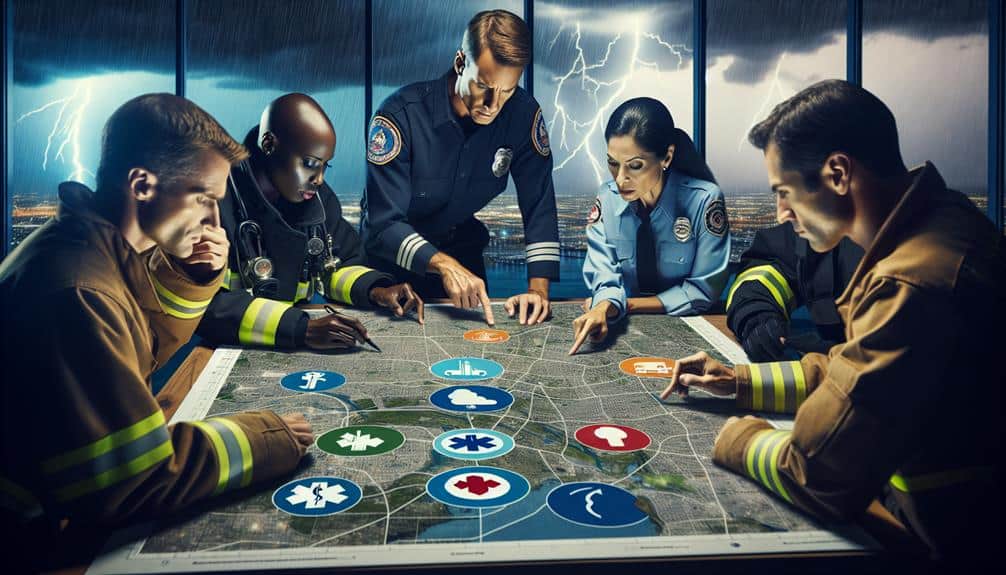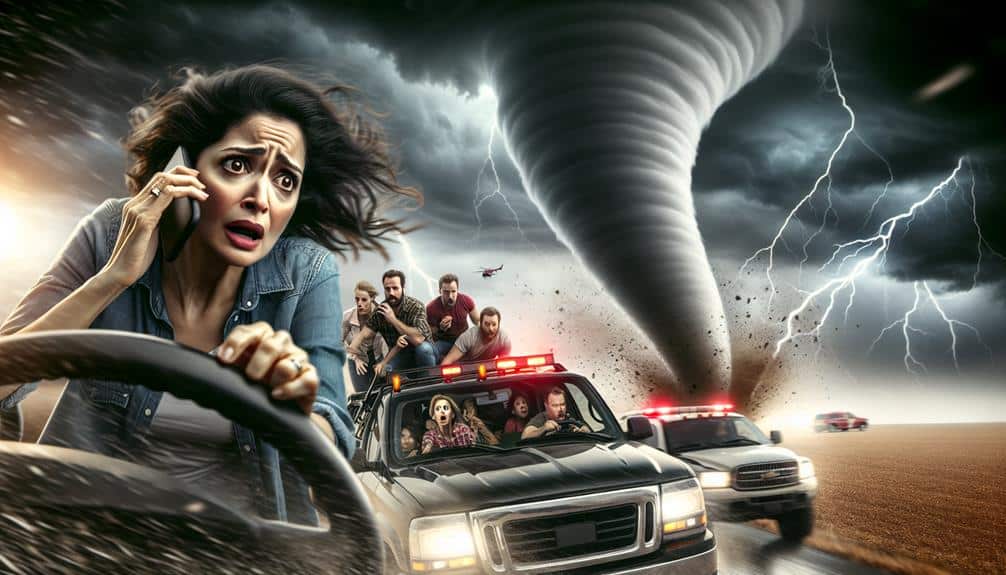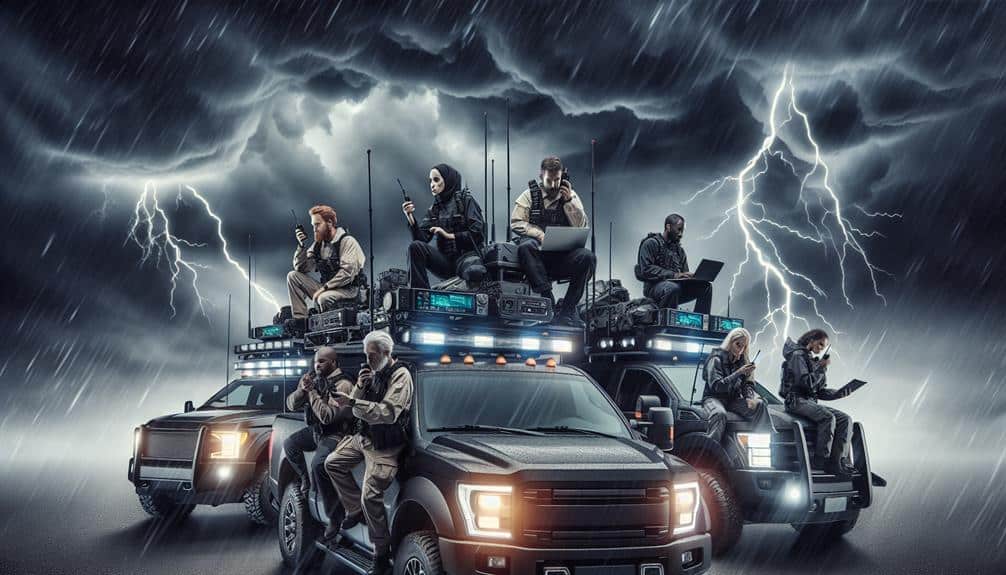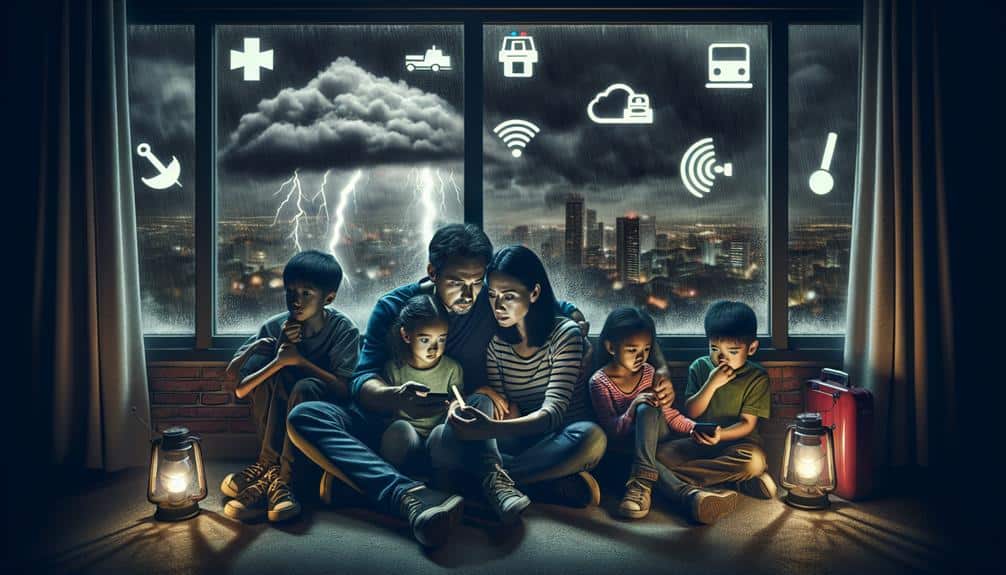Clear communication is essential for storm safety because it allows us to quickly disseminate accurate information, ensuring everyone knows the imminent risks and how to respond. With accurate, real-time updates, we can allocate resources effectively and coordinate with local authorities to prioritize emergency services. Sharing precise weather data through various channels helps prevent misinformation and confusion. Clear alerts enable the public to take timely action, reducing the risk to lives and property. By maintaining open and transparent communication, we empower communities to make informed decisions and respond swiftly during a storm. Continuation reveals more on optimizing storm preparedness.
Key Points
- Clear communication ensures timely resource allocation and prioritization of emergency services.
- It allows real-time information sharing, aiding effective monitoring and deployment of resources.
- Community engagement through clear communication gathers firsthand storm reports for better decision-making.
- Accurate, multi-channel weather data dissemination enables individuals to prepare and minimize risks.
Importance of Timely Updates
Timely updates are necessary for guaranteeing that communities can adequately prepare for approaching storms. When we receive emergency notifications promptly, we gain the ability to take immediate, informed actions. This rapid response can greatly reduce the risks associated with severe weather events. By engaging our community through clear and timely communication, we enhance public awareness and make sure that everyone understands the potential impact of the storm.
In our communities, emergency notifications play an important role in storm preparation. They provide us with real-time information about the storm's path, intensity, and expected arrival. This precise data allows us to make vital decisions, such as whether to evacuate or secure our property. When these notifications are delayed or unclear, our ability to respond effectively diminishes, putting lives and property at greater risk.
Moreover, community engagement is essential in disseminating these updates. By leveraging social media, local news, and other communication channels, we can guarantee that everyone stays informed and ready to act. In enhancing public awareness, we empower individuals to take proactive steps, fostering a sense of freedom and control amidst the uncertainty of storms.
Timely updates, hence, aren't just about information—they're about enabling us to protect our communities.
Coordinating With Local Authorities
Effective storm safety relies on our ability to coordinate seamlessly with local authorities. When a storm threatens, our collaboration with local partnerships becomes vital. These partnerships guarantee that resources are allocated efficiently and that everyone in the community stays informed and prepared.
By engaging with local authorities, we can streamline emergency response efforts and avoid duplication of efforts, which can be critical when every second counts. Community engagement plays a central role in this coordination. We need to tap into the local knowledge and networks that these authorities possess. This helps us tailor our communication and emergency plans to the specific needs and vulnerabilities of our community.
By fostering strong relationships with local leaders, we can create a unified front that enhances the overall resilience of our community. Moreover, effective coordination with local authorities allows us to leverage their expertise and resources. They often have access to critical information and logistical support that can make a significant difference during a storm.
Through transparent and timely communication, we can guarantee that everyone— from first responders to residents— has the information and resources they need to stay safe, thereby preserving our collective freedom and well-being.
Sharing Accurate Weather Data
To guarantee everyone's safety, we must prioritize sharing real-time weather updates from verified sources. Accurate and timely information allows us to make informed decisions quickly.
Additionally, we should focus on simplifying data interpretation to secure clear communication.
Real-Time Weather Updates
Accurate real-time weather updates are important for maintaining public safety during storms. By leveraging advanced weather tracking technologies, we can provide timely and precise information that keeps our communities well-informed and engaged.
When storms are imminent, these updates allow us to implement effective disaster preparedness measures. This means having clear communication strategies in place to disseminate information quickly and accurately, thereby empowering individuals to make informed decisions.
In the age of digital connectivity, real-time updates can be shared across multiple platforms, from social media to emergency alert systems. This multi-channel approach ensures that critical weather information reaches as many people as possible.
For instance, when we receive updates about changing storm paths or intensities, we can immediately relay this important data to the community, enabling swift action like evacuations or securing property.
Moreover, real-time weather updates foster a sense of agency and autonomy. Knowing what to expect and when empowers us to prepare adequately and minimize risks.
Through collaborative efforts in weather tracking and community engagement, we can enhance our disaster preparedness and communication strategies, ultimately safeguarding lives and property during severe weather events.
Reliable Source Verification
Verifying the reliability of our weather updates demands that we confirm information from trusted sources before sharing it with the community. This step is essential in maintaining the integrity of the data we provide, especially when lives and property are at stake. By cross-referencing weather forecasts and alerts with reputable agencies like the National Weather Service and local meteorological stations, we confirm that the information we relay is both accurate and timely.
Our dedication to disseminating trustworthy information extends to verifying the authenticity of emergency contacts. In times of severe weather, accurate emergency contacts can mean the difference between swift action and delayed response. We vet these contacts thoroughly to confirm that the community can rely on them for immediate assistance and accurate guidance.
Furthermore, we grasp the significance of transparency in communication. When we share weather updates, we cite our sources, giving our audience confidence in the data's dependability. This practice not only fosters trust but also empowers individuals to make informed decisions about their safety.
Simplified Data Interpretation
Understanding and conveying weather data in a simplified manner ensures our community can quickly grasp essential information and take appropriate actions. We're aware that during storms, time is crucial. By presenting data clearly, we make certain that everyone, regardless of their background, can understand and respond swiftly.
Data accuracy is paramount. If we share precise weather data, we reduce the likelihood of misinformation and confusion. Accurate data allows individuals to prepare effectively, adhering to established safety protocols. Picture a scenario where storm warnings are cluttered with technical jargon; the delay in comprehension could cost valuable time and resources. Simplified data interpretation eliminates this risk, fostering a quick and decisive response.
Furthermore, simplified data interpretation empowers individuals. When we break down complex meteorological information into straightforward terms, we enable our community to make informed choices without feeling overwhelmed. This approach respects their autonomy and reinforces their capacity to act independently. By doing so, we uphold the principles of freedom and responsibility.
Alerting Public of Dangers
We must swiftly distribute clear and concise warnings to the public to reduce the risks posed by impending storms. Emergency notifications are vital for guaranteeing that everyone receives timely information about potential hazards. Through community outreach, we can bridge the gap between meteorological data and actionable insights, empowering individuals to take necessary precautions.
Public awareness is the cornerstone of disaster preparedness. When we communicate effectively, we enable people to make informed decisions that can save lives and property. Utilizing various channels like social media, local news, and text alerts guarantees our messages reach a broad audience. However, clarity is paramount; jargon-free language helps prevent misunderstandings that can lead to dangerous delays or inappropriate actions.
In addition, our approach to alerting the public must be proactive. Waiting until the last minute can worsen panic and confusion. By providing regular updates as a storm approaches, we maintain a well-informed populace ready to act. This continuous information flow fosters a sense of control and autonomy, essential for a community that values freedom and self-reliance.
Ultimately, the goal is to create a resilient community through effective communication, making sure that everyone understands the risks and knows how to respond appropriately.
Ensuring Efficient Resource Allocation

We must focus on real-time information sharing to guarantee our resources are allocated efficiently during a storm.
By prioritizing emergency services based on up-to-date data, we can address the most critical needs first.
This approach minimizes response time and maximizes the effectiveness of our efforts.
Real-Time Information Sharing
Timely sharing of up-to-date information is vital for efficiently allocating resources during a storm emergency. Effective communication channels allow us to disseminate essential updates and coordinate our response efforts accurately. When we leverage these channels, such as social media, emergency alert systems, and local news broadcasts, we guarantee that every stakeholder is informed promptly. This not only aids in deploying resources where they're most needed but also minimizes redundancy and waste.
Community engagement plays an important role in this process. By fostering open lines of communication with local residents, we can gather firsthand reports of storm conditions and damages, aiding our decision-making process. Residents who are well-informed about the evolving situation are more likely to cooperate with evacuation orders and other safety measures, thereby reducing chaos and ensuring smoother operations.
In addition, real-time information sharing helps us monitor resource availability and track their deployment effectively. This ensures that medical supplies, rescue teams, and other essential services are directed to areas with the greatest need. By maintaining a dynamic flow of information and engaging actively with the community, we enhance our capability to respond swiftly and decisively, ultimately safeguarding lives and property.
Prioritizing Emergency Services
Prioritizing emergency services involves a systematic approach to guarantee that essential resources are allocated where they're needed most during a storm crisis. Efficient emergency response hinges on clear communication channels. We need to make certain that our first responders have real-time information to make swift decisions. By doing so, we maximize the effectiveness of our efforts and minimize the impact on affected communities.
Effective community outreach plays a pivotal role in this process. By maintaining open lines of communication with residents, we can better understand their needs and prioritize resources accordingly. This means coordinating with local leaders and utilizing social media platforms to disseminate accurate information quickly. When we engage with the community, we build trust, which is important for successful emergency management.
Resource allocation is another significant factor. We must have a clear plan for deploying personnel, equipment, and supplies to areas that require immediate attention. This involves pre-storm planning and continuous assessment during the crisis. By clearly communicating our strategy and priorities, we make sure that every team member understands their role and responsibilities.
Real-Time Response Strategies
Effective real-time response strategies rely on streamlined communication channels and decisive action plans. When facing a storm, our first priority must be to guarantee effective communication and robust emergency preparedness. This means utilizing technology to send clear, timely alerts to the public and coordinating with emergency services to implement safety measures quickly. Every second counts, so our communication systems must be reliable, fast, and capable of reaching a broad audience.
We also need to establish a chain of command that all responders understand. Clear roles and responsibilities prevent confusion and allow for swift decision-making. Coordination between local authorities, emergency responders, and community leaders ensures everyone is on the same page, and resources are utilized efficiently.
Additionally, real-time data analytics play a vital role in our strategies. By continuously monitoring weather conditions and infrastructure status, we can make informed decisions on the fly. Predictive models help us anticipate potential issues and proactively address them.
In essence, our freedom to act effectively during a storm depends on how well we communicate and prepare in advance. With streamlined communication and decisive actions, we can mitigate risks and safeguard our communities.
Frequently Asked Questions
How Can Individuals Prepare for a Storm in Advance?
We can prepare for a storm by making sure our emergency kits are stocked with essentials and our evacuation plans are clear. This proactive approach safeguards our freedom and guarantees we're prepared for any emergency.
What Role Do Social Media Platforms Play in Storm Communication?
When it comes to storm communication, social media platforms are a godsend. They provide real-time updates and foster community engagement, keeping us all informed and connected. This enables us to react swiftly and efficiently.
How Can Communities Support Vulnerable Populations During a Storm?
We can support vulnerable populations during a storm through community outreach, providing necessary resources, and organizing volunteer efforts. Establishing and maintaining accessible shelters guarantees everyone has a safe place to go when storms hit.
What Are the Best Practices for Businesses During Severe Weather Events?
In severe weather, we prioritize precise emergency protocols and clear communication strategies. We must guarantee staff safety, streamline shelter procedures, and maintain continuous contact. By doing so, we safeguard our team and uphold operational integrity.
How Can Technology Improve Storm Tracking and Prediction?
We can improve storm tracking and prediction using satellite imagery, radar, and drones. Weather apps provide real-time updates, empowering individuals with the freedom to make informed safety decisions during severe weather events.


